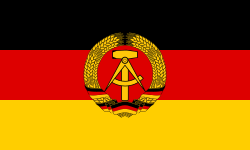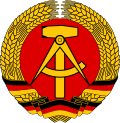អាល្លឺម៉ង់ខាងកើត (អាល្លឺម៉ង់: Ostdeutschland ) ឈ្មោះជាផ្លូវការ សាធារណរដ្ឋប្រជាធិបតេយ្យអាល្លឺម៉ង់ គឺជាប្រទេសមួយនៅអឺរ៉ុបកណ្តាល ដែលមានតាំងពីការបង្កើតនៅថ្ងៃទី៧ ខែតុលា ឆ្នាំ១៩៤៩ រហូតដល់ការរំលាយនៅថ្ងៃទី៣ ខែតុលា ឆ្នាំ១៩៩០។ ត្រូវបានគេចាត់ទុកជាទូទៅថាជារដ្ឋកុម្មុយនិស្ត រដ្ឋនេះបានពណ៌នាខ្លួនឯងថាជាសង្គមនិយម "កម្មករ និងរដ្ឋកសិករ"។ ទឹកដីរបស់ខ្លួនត្រូវបានគ្រប់គ្រង និងកាន់កាប់ដោយកងកម្លាំងសូវៀត បន្ទាប់ពីការចុះចាញ់របស់ណាស៊ីអាល្លឺម៉ង់ បន្ទាប់ពីសង្គ្រាមលោកលើកទី២ នៅពេលដែលកិច្ចព្រមព្រៀងផតស្ដាម បានបង្កើតតំបន់កាន់កាប់របស់សូវៀត ដែលមានព្រំប្រទល់ខាងកើតដោយខ្សែអូឌឺរ-នីស្ត៍។ តំបន់សូវៀតបានឡោមព័ទ្ធទីក្រុងប៊ែរឡាំងខាងលិច ប៉ុន្តែមិនរួមបញ្ចូលខ្លួនទេហើយប៊ែរឡាំងខាងលិចនៅតែស្ថិតនៅក្រៅដែនសមត្ថកិច្ចរបស់សាធារណរដ្ឋប្រជាធិបតេយ្យអាល្លឺម៉ង់ ។ ពីឆ្នាំ១៩៤៩ ដល់ឆ្នាំ១៩៨៩ ប្រទេសអាល្លឺម៉ង់ខាងកើតគឺជាផ្នែកមួយនៃប្លុកបូព៌ាក្នុងសង្រ្គាមត្រជាក់។ អ្នកប្រាជ្ញ និងអ្នកសិក្សាភាគច្រើនពណ៌នាសាធារណរដ្ឋប្រជាធិបតេយ្យអាល្លឺម៉ង់ ថាជារបបអំណាចផ្តាច់ការ។
ព័ត៌មានសង្ខេប Deutsche Demokratische Republik, ស្ថានភាព ...
German Democratic Republic| Deutsche Demokratische Republik |
|---|
| 1949–1990 |
|
បាវចនា
"Proletarier aller Länder, vereinigt Euch!"
("Workers of the world, unite!") |
ភ្លេងជាតិ" Auferstanden aus Ruinen" ("Risen from Ruins") |
 Territory of East Germany (green) |
| ស្ថានភាព | {{#if: | |Member of Comecon (1950–1990)[២]
Member of the Warsaw Pact (1955–1989)[៣] |
|---|
ធានី
និង ទីក្រុងធំបំផុត | East Berlin[lower-alpha ១] (de facto) |
|---|
| ភាសាផ្លូវការ | German
Sorbian (in parts of Bezirk Dresden and Bezirk Cottbus) |
|---|
| សាសនា | See Religion in East Germany |
|---|
| រដ្ឋាភិបាល | Federal Marxist–Leninist one-party socialist republic
(1949–1952)
Unitary Marxist–Leninist one-party socialist republic
(1952–1989)
Unitary parliamentary republic
(1989–1990) |
|---|
| នីតិបញ្ញត្តិ | Volkskammer |
|---|
- Upper house | Länderkammer[lower-alpha ២] |
|---|
| 16 June 1953 |
- Warsaw Pact | 14 May 1955 |
|---|
- Basic Treaty with the FRG | 21 December 1972 |
|---|
| 18 September 1973 |
|---|
- Peaceful Revolution | 13 October 1989 |
|---|
- Fall of the Berlin Wall | 9 November 1989 |
|---|
- Final Settlement | 12 September 1990 |
|---|
| ក្រឡាផ្ទៃ |
|---|
- ផ្ទៃសរុប | គ.ម២ |
|---|
| ប្រជាជន |
|---|
|
▪ 1950 | 18,388,000[lower-alpha ៣][៤] |
|---|
▪ 1970 | 17,068,000 |
|---|
▪ 1990 | 16,111,000 |
|---|
|
|
- ដង់ស៊ីតេ | 149 នាក់/គ.ម២ |
|---|
| GDP (PPP) | ប៉ាន់ស្មាន (ឆ្នាំ 1989) |
|---|
- សរុប | $525.29 billion[៥] |
|---|
- ក្នុងម្នាក់ | $26,631[៥] |
|---|
| HDI (1990 formula) | 0.953[៦]
ខ្ពស់ណាស់ |
|---|
| រូបិយវត្ថុ |
- East German mark (1949–1990), officially named:
- Deutsche Mark (1949–1964)
- Mark der Deutschen Notenbank (1964–1967)
- Mark der DDR (1967–1990)
- Deutsche Mark (from 1 July 1990)
|
|---|
| ល្វែងម៉ោង | (UTC+1) |
|---|
| ទិសបើកបរ | right |
|---|
| កូដហៅទូរស័ព្ទ | +37 |
|---|
| ដែនកម្រិតខ្ពស់ | .dd[lower-alpha ៤][៧] |
|---|
| Preceded by | Succeeded by |
|
Soviet occupation zone of Germany |
|
|
|
| សព្វថ្ងៃជាផ្នែកនៃ | Germany |
|---|
The initial flag of East Germany adopted in 1949 was identical to that of West Germany. In 1959, the East German government issued a new version of the flag bearing the national emblem, serving to distinguish East from West. |
បិទ
[១]



